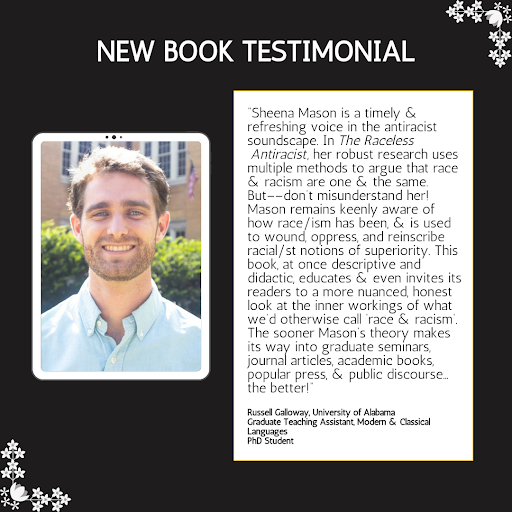THE RACELESS ANTIRACIST: WHY ENDING RACE IS THE FUTURE OF ANTIRACISM
Many scholars and activists argue that the practice of racialization and the belief in race are necessary because even if race is not real, racism is. While such an approach might help lessen some effects of racism, it inevitably strengthens the very foundation of racism. As Sheena Michele Mason argues in The Raceless Antiracist, fighting racism by ignoring or upholding the idea of race and the practice of racialization is like trying to stop a flood by dousing it with water. To end racism, particularly antiblack racism, we must question, acknowledge, and translate race as an integral part of racism itself. In presenting her case for charting a future without racism, Mason weaves insights from philosophy, sociology, statistics, biology, history, and literary studies. She presents a map, which she refers to as the “togetherness wayfinder,” for how to discuss, teach, identify, and stop the causes and effects of racism without hardening any of its components. With this guide, we can end the idea of race and the practice of racialization and start to navigate more effectively toward a post-racist world.
“Race supports a hierarchy of being and was created in enthusiastic support of “white” supremacy. It wasn’t made to reconcile us but to ensure that we live in comparison—side by side but never together. Instead, it is the invented problem to keep us going back and forth, back and forth. Us versus them, race’s dehumanization knows no ends. It has no boundaries. Consequently, we need words that hem it in, that get in front of and behind it, that are not just antiracism or antiracist but anti-race,”
“In the United States, we have long needed a toolkit that enables us to keep the ethno-cultural parts of us that provide value while discarding that which keeps us divided and within the throes of our type of racism: anti-blackness,”
“We need a raceless space, a place outside of the confines of race/ism, to identify, analyze, and solve racism itself. The raceless space the theory invites people into is not a “white” or colorblind place where people are encouraged to miss or hide the reality of racism. Instead, one becomes increasingly aware of how whiteness and racialization more broadly operate. That clarity opens ways for more people to unify, reconcile, and heal and create a better future for all without race/ism”
“The language, knowledge, and tools of the theory of racelessness help us do that if we open our imaginations to the probability of a new way forward. Racelessness is the best and most viable future of antirace/ism”
“There are six philosophies of “race.” Three answer the question “What is race:” “Race” is hereditary, synthetic, or imaginary. The other three answer “What should we do about race:” We should preserve, reform, or terminate “race.” Each of us holds two philosophies of “race” even without the language to name them”







